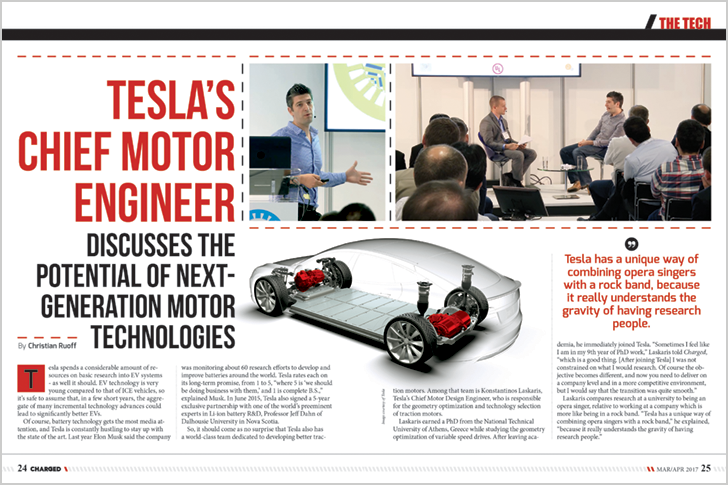Tesla spends a considerable amount of resources on basic research into EV systems – as well it should. EV technology is very young compared to that of ICE vehicles, so it’s safe to assume that, in a few short years, the aggregate of many incremental technology advances could lead to significantly better EVs.
Of course, battery technology gets the most media attention, and Tesla is constantly hustling to stay up with the state of the art. Last year Elon Musk said the company was monitoring about 60 research efforts to develop and improve batteries around the world. Tesla rates each on its long-term promise, from 1 to 5, “where 5 is ‘we should be doing business with them,’ and 1 is complete B.S.,” explained Musk. In June 2015, Tesla also signed a 5-year exclusive partnership with one of the world’s preeminent experts in Li-ion battery R&D, Professor Jeff Dahn of Dalhousie University in Nova Scotia.
So, it should come as no surprise that Tesla also has a world-class team dedicated to developing better traction motors. Among that team is Konstantinos Laskaris, Tesla’s Chief Motor Design Engineer, who is responsible for the geometry optimization and technology selection of traction motors.

Laskaris earned a PhD from the National Technical University of Athens, Greece while studying the geometry optimization of variable speed drives. After leaving academia, he immediately joined Tesla. “Sometimes I feel like I am in my 9th year of PhD work,” Laskaris told Charged, “which is a good thing. [After joining Tesla] I was not constrained on what I would research. Of course the objective becomes different, and now you need to deliver on a company level and in a more competitive environment, but I would say that the transition was quite smooth.”
Laskaris compares research at a university to being an opera singer, relative to working at a company which is more like being in a rock band. “Tesla has a unique way of combining opera singers with a rock band,” he explained, “because it really understands the gravity of having research people.”
Potential of next generation motor technologies
“Tesla has a unique way of combining opera singers with a rock band, because it really understands the gravity of having research people”
“Tesla has a unique way of combining opera singers with a rock band, because it really understands the gravity of having research people”
“Seeing your design going to production in a car like Model S, what could be more rewarding for a motor design engineer?” he added. “Of course the environment sometimes is very competitive. There are so many good engineers that are very involved with what you are doing. It makes sense that it is a bit stressful, but the reward is huge, because the objectives of the company are big. It makes you feel really good about your design work that your work is being appreciated.”
I had the chance to interview Laskaris for the keynote at the Coil Winding, Insulation & Electrical Manufacturing Exhibition (CWIEME) in Berlin. It was clear that Laskaris wasn’t at liberty to talk about the specifics of Tesla’s motor technology – often the case when interviewing engineers from major automakers – so I didn’t bother asking. Instead, since Laskaris sits at the forefront of determining what new motor technologies are ready for commercialization, I asked him for his general thoughts on some interesting new research areas and their near-term potential for the EV industry.

Read more at: https://chargedevs.com/features/teslas-chief-motor-engineer-discusses-the-potential-of-next-generation-motor-technologies/
Photo Credit: chargedevs.com/


